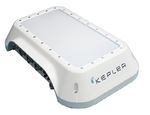POLAR TELECOMMUNICATIONS WITH NANOSATELLITES - THE FUTURE OF CONNECTIVITY WHITE PAPER SERIES - KEPLER COMMUNICATIONS
←
→
Page content transcription
If your browser does not render page correctly, please read the page content below
The Earth’s polar regions present significant Tourism in Antarctica is more nascent
challenges for individuals, enterprise, scientists, but growing. More than 500,000 people visited
and governments that operate within them. in 2017, with 17% yearly growth.1 It consists
While variations in geography, climate, and primarily of adventure tourism on vessels,
infrastructure make it difficult to broadly allowing travellers the chance to disembark to
characterize the poles, one key challenge of these explore the landscape and wildlife.
regions that remains unsolved is access to reliable Resources. Although the last few years
and affordable connectivity. have seen a decline in resource exploration
Polar activity has been steadily increasing activities in the Arctic as a result of lower
across a variety of industries. With this increased commodities pricing, it is generally accepted that
interest comes the question of whether existing the Arctic is poised to be a major site of resource
infrastructure can support an ever-growing exploration in the coming years. This will include 1. Remote and Sparsely Populated
Science. Scientific activity in the Arctic is
demand for connectivity. exploration both on and offshore. Large distances between subscribers and a
incredibly diverse, with hundreds of permanent
Tourism. Arctic tourism is a mature and Shipping. Receding ice has opened the low subscriber volume make it uneconomical
and semi-permanent research stations already
substantial industry, because it includes those possibility of new Arctic shipping lanes that
established. These stations are actively studying to deploy fixed infrastructure. Lower cost DSL
travelling to the high latitude regions of the eight would dramatically reduce travel time and fuel
everything from the atmosphere and cryosphere connectivity (i.e. copper wires) is limited to only
Arctic Member States (US, Canada, Norway, consumption. A trip from London to Tokyo, for
to marine life, as well as human activity and a few 10s of kilometers, making it unsuitable for
Iceland, Sweden, Finland, Denmark, and Russia). example, would be shortened to 8,000 miles if
society. backhauling.
Arctic tourism includes everything from stays in routed through the Northwest Passage, instead
The vast majority of human activity on 2. Extreme Climates
5-star hotels in Reykjavik, to boat cruises to view of the nearly 15,000 mile current route through
Antarctica is scientific. Dozens of research stations Extreme cold, high winds, and heavy snow make it
glaciers in Alaska. the Suez Canal.
are operated by the more than 50 countries that hard to maintain infrastructure. Cell towers, fiber
are signatories to the Antarctic Treaty, with most cables, or backhaul stations are easily damaged.
“ Polar activities have been steadily growing across a variety of industries,
scientists focusing on environmental studies. Equipment installations can be affected by
prompting concern on the ability for existing infrastructure to keep up”
permafrost, such as with underground fiber lines.
WHY IS CONNECTIVITY TOUGH? 3. Geography
In Short Finding a provider of robust and affordable The highly mountainous terrain of many
connectivity in the poles is a considerable parts of the polar regions presents two key
The Problem The Why The Solution challenge. Outside of the more densely populated challenges to establishing communications
Increased polar interests has Remote populations, A new class of low-cost regions in Iceland, Scandinavia and parts of infrastructure. First, the cost of deploying fiber
cast doubt on the ability for difficult geography, and an nanosatellites focused
western Russia, communications infrastructure optic backhaul skyrockets in this geography. And
existing telecommunications extreme climate make it very specifically on the poles can
infrastructure to support challenging to deploy new alleviate the connectivity is either exceptionally poor, or completely non- second, microwave backhaul can be impeded
activities infrastructure woes
existent. This reality is not surprising, owing to by mountains since it requires line-of-sight to
1
IAATO (2017). Tourism Statistics. Retrieved from https://iaato.org/tourism-statistics the following factors: neighbouring towers.4. Offshore Activities However, when it comes to polar NEW-GEN SATELLITE SERVICES While a single satellite is sufficient to provide
Although not unique to the polar regions, the connectivity, a significant challenge for satellite global coverage including the poles, capacity
Communications in the poles is complex. There
considerable offshore activity in these areas services is that it becomes unreliable at high is augmented with every satellite added to the
is no single solution that can address all the
leaves a multitude of vessels and offshore latitudes. Most communication satellites operate constellation.
challenges faced by those who operate in these
platforms particularly limited by connectivity, in geostationary orbit, which is about 35,000
regions. Instead, a number of solutions will be
since they have no means of acquiring fixed line km in altitude and fixed on the equator. At high
needed, combining the strengths of traditional
access to land when far from shore. latitudes, the view from ground to a satellite is
fixed infrastructure, as well as contemporary and
blocked by the curvature of the earth.
new satellite systems.
LOOKING TO SATELLITES Local phenomena can also create
A new generation of satellite technology
When terrestrial infrastructure cannot provide significant problems for satellite communication.
will be a critical component of the overall
reliable and affordable connectivity, users turn to Mountainous terrain can block the view of
solution for communication in the polar regions.
satellite systems to support their communication satellites from many locations. On ocean vessels,
Constellations of low-cost, breadbox-sized nano- Kepler’s satellites are capable of providing high-
needs. Satellites provide a broad range of rolling waves can intermittently block the view of
satellites, flying in low Earth orbit, will provide data-rate store-and-forward services through
connectivity options, including broadband satellites, which will cause disconnections that
affordable data services for those situated at the the use of Ku-band where signals from the user
internet to entire communities via fixed antenna, render the service unreliable. And we can’t forget
polar extremes. terminal on the ground are decoded and stored
mobile connectivity for maritime applications that satellites are exceptionally expensive, with
digitally on the satellite. Thereafter, the same in-
through VSAT (Very Small Aperture Terminal) data costs exceeding terrestrial by 10 or even 100
WHY KEPLER’S LEO SATELLITES?
formation is downlinked to Kepler’s gateway at
systems, as well as satellite phone services. times! Low-Earth-orbiting polar satellites have
northern Canada. This allows for an effective use
significantly higher coverage at the poles,
of bandwidth and reduces the need for multiple
making them uniquely positioned to provide
ground station sites in order to provide a global
Beyond the Horizon communication services in these latitudes. A
Above 80 degrees latitude, the curvature of the earth completely blocks visibility of traditional geostationary service (unlike in the case of a bent pipe type of
single low-Earth-orbit satellite, at no more than
satellites. Between 70-80 degrees, shown below, local obstructions llike hills or canopy can limit visibility. communication service).
2,000 km from the planet, circles the Earth every
90 minutes. Weighting less than 5 kg and with a This also increases the speed with which large
10cmx10cmx34cm shape our satellites are not amounts of data can be transferred across the
only much cheaper and faster to launch, but they network, as portions of data can be uplinked to
can also be replaced every 3 years meaning they multiple satellites as they pass over a given user
can rapidly incorporate new technologies. terminal (rather than waiting for the return of a
single satellite).With a shoebox sized satellite, Kepler’s network 2. Media Vaults KEPLER’S INNOVATION Kepler is expecting alpha prototypes to be
is capable of moving upwards of 5 GB of data per Transport high bandwidth media content MODEM available in late 2018 for early customer testing
10-minute pass from a single location. This means (e.g. Netflix) to a local server, giving access to and beta prototypes to be available in 2019. With
Kepler’s software defined radio (SDR) offers
a total of 75GB/day can be transferred from passengers on cruise vessels, small communities, a single fully integrated unit, the unit cost of these
flexibility in center frequency and channel
the poles with a single satellite. Now imagine a remote mines, or offshore platforms. terminals will be less than $5000 US dollars.
size, allowing for a more versatile modem that
constellation of them! 3. Local Drop Boxes
is compatible with multiple service devices.
Provide your community, cruise ship passengers,
LET’S TALK APPLICATIONS This technology can be partnered with other
or mining personnel a means of sharing large,
service providers to deliver a multi-layered,
Kepler’s non-geostationary satellite network bandwidth-intensive files without clogging your
comprehensive telecommunications service to
and high-capacity store-and-forward backhaul real-time links.
customers using a single rack-mounted modem. Kepler’s SDR is already capable of modulating and de-modulating
service gives polar customers the ability to shift to the DVB-S2 standard up to 32-APSK with adaptive modulation
encoding.
Customers access the service using user terminal
their delay-tolerant data to a more economical
systems. A customer will have the option of either
connectivity service. WRAPPING UP
ANTENNAS
moving data from their terminal to a standard,
This will reduce congestion on users’ real-time Thanks to Kepler’s custom designed modem
Internet-accessible gateway, or to another user While a wide variety of activities in the polar
links, increase available bandwidth for their -compatible with any off-the-shelf mechanically
terminal of their choosing. regions continue to gain interest, connectivity
activities, and reduce the overall cost per GB of steerable dish- customers can use their existing
has remained a significant challenge, and
connectivity. Applications for store-and-forward antennas eliminating switching costs.
Service plans are available in two tiers: basic oftentimes a deterrent, to those activities
services offered by Kepler include:
access and priority access. The latter option is When considering cold-weather deployments, being undertaken more broadly. New
1. Scientific Data
available to customers who pay a premium to electronically steerable antennas provide a key satellite technology, combined with existing
Send and receive large quantities of scientific data
move their data through the network at a higher advantage over their mechanical counterparts. infrastructure and contemporary satellite
such as undersea mapping data, environmental
priority, thus being able to move more data faster. A typical mechanically steerable antenna’s gears systems, offers the promise of reliable and
logs or meteorological data.
and lubricants limit its ability to perform in cold inexpensive communications in all parts of the
weather, as the moving parts run the risk of globe. Kepler is leading the industry in making
freezing up when the ambient temperature drops this solution available in the polar regions.
LOOKING TO SATELLITES below -25C.
By contrast, electronically steerable antennas
have no moving parts and in fact benefit from
cold ambient temperatures. The work on this Kepler Communications Inc Web:
technology that Kepler is doing with its partner, 355 Adelaide St W, Suite 500 www.kepler.space
Toronto, Canada
Phasor Solutions, will bring to market an For more info:
M5V 1S2
sales@kepler.space
integrated antenna and modem terminal that
will be ideally suited for deployments in polar
Phone:
environments. +1.437.537.5371You can also read

























































